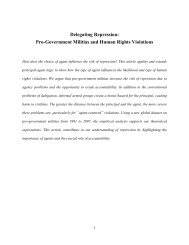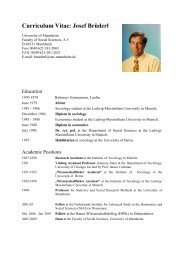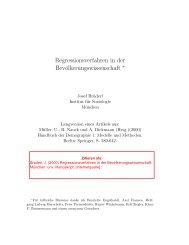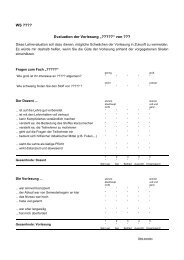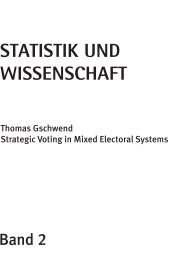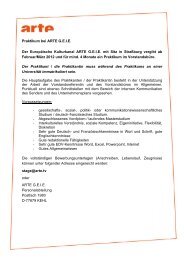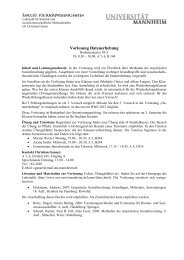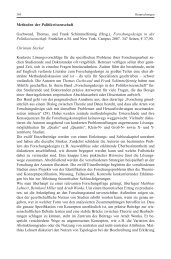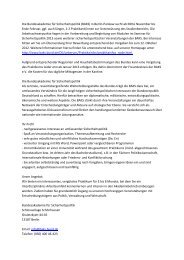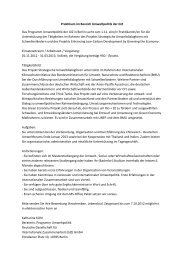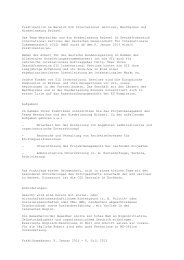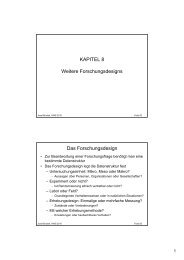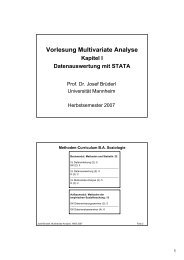Panel Data Analysis, Josef Brüderl - Sowi
Panel Data Analysis, Josef Brüderl - Sowi
Panel Data Analysis, Josef Brüderl - Sowi
You also want an ePaper? Increase the reach of your titles
YUMPU automatically turns print PDFs into web optimized ePapers that Google loves.
<strong>Panel</strong> <strong>Data</strong> <strong>Analysis</strong>, <strong>Josef</strong> Brüderl 13<br />
This test, however, is based on strong assumptions which are usually not met in<br />
finite samples. Often it does even not work (as with our data).<br />
FE- or RE-Modelling?<br />
1. For most research problems one would suspect that Covx it , i ≠ 0. The<br />
RE-estimator will be biased. Therefore, one should use the FE-estimator to get<br />
unbiased estimates.<br />
2. The RE-estimator, however, provides estimates for time-constant covariates.<br />
Many researchers want to report effects of sex, race, etc. Therefore, they<br />
choose the RE-estimator over the FE-estimator. In most applications, however,<br />
the assumption Covx it , i 0 will be wrong, and the RE-estimator will be<br />
biased (though the magnitude of the bias could be low). This is risking to throw<br />
away the big advantage of panel data only to be able to write a paper on "The<br />
determinants of Y". To take full advantage of panel data the style of data<br />
analysis has to change: One should concentration on the effects of (a few)<br />
time-varying covariates only and use the FE-estimator consequently!<br />
3. The RE-estimator is a special case of a parametric model for unobserved<br />
heterogeneity: We make distributional assumptions on the person-specific<br />
error term and conceive an estimation method that cancels the nuisance<br />
parameters. Generally, such models do not succeed in solving the problem of<br />
unobserved heterogeneity! In fact, they work only if there is "irrelevant"<br />
unobserved heterogeneity: Covx it , i 0.<br />
Further Remarks on <strong>Panel</strong>-Regression<br />
1. Though it is not possible to include time-constant variables in a FE-regression,<br />
it is possible to include interactions with time-varying variables. E.g., one could<br />
include interactions of education and period-effects. The regression<br />
coefficients would show, how the return on education changed over periods<br />
(compared to the reference period).<br />
2. Unbalanced panels, where T differs over individuals, are no problem for the<br />
FE-estimator.<br />
3. With panel data there is always reason to suspect that the errors it of a person<br />
i arecorrelatedovertime(autocorrelation). Stata provides xtregar to fit<br />
FE-models with AR(1) disturbances.<br />
4. Attrition (individuals leave the panel in a systematic way) is seen as a big<br />
problem of panel data. However, an attrition process that is correlated with i<br />
does not bias FE-estimates! Only attrition that is correlated with it does. In our<br />
example this would mean that attrition correlated with ability would not bias<br />
results.<br />
5. <strong>Panel</strong> data are a special case of "clustered samples". Other special cases are<br />
sibling data, survey data sampled by complex sampling designs<br />
(svy-regression), and multi-level data (hierarchical regression). Similar models<br />
are used in all these literatures.



